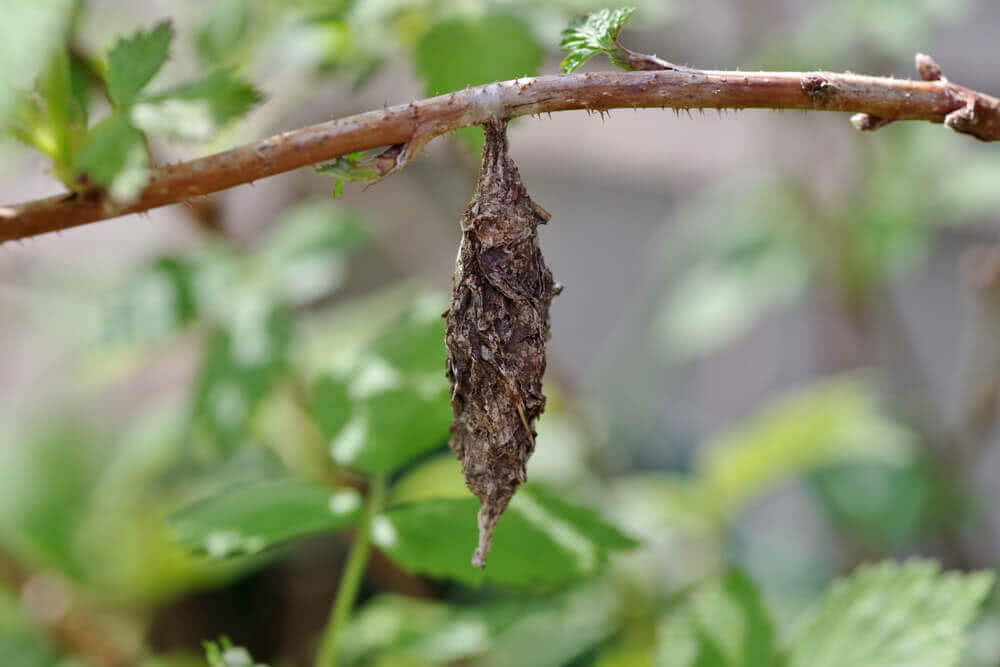What are Bagworms?
Bagworms are moths that feed on shrubs and trees during their larval stage. They pesky pests are small and create little diamond-shaped bags on arborvitae. They love deciduous trees, coniferous trees, fruit trees and perennial flowers. Bagworms are sneaky pests as they camouflage their web with bits of the tree they live on.
Appearance and Habits:
Bagworms are the larva or caterpillar stages of moths. Soon after hatching they spin a cocoon-like bag to attached with pieces of leaves from the plants they feed upon. Initially, the bags are around 1/8 inch long. Bagworms move freely to feed and carry along these bags. The bags grow large during summer for the growing caterpillar to thrive. Read about how to get rid of caterpillars in vegetable garden.

Are Bagworms Poisonous?
No bagworms are not poisonous. They cause the death of plants due to feeding on their foliage.
Life Cycle of Bagworms:
- The eggs hatch in June first week. Bagworms complete their growth by August or early September.
- The 1-2 inch long bags are permanently attached to plant twigs with strong silken threads.
- In late summer they pupate inside the bags and then transform into moths.
- Only male bagworms have wings.
- The males emerge from their bags in late summer and then fly to the bags containing females.
- The males then mate with the wingless females that remain in their bags.
- Each female lays about 200 to 1,000 eggs in its bag and dies.
- The eggs remain in the bags until they hatch in spring.
Damage caused by bagworms:
- High bagworm population results in severe plant damage.
- Shrubs and trees that become heavily infested, particular conifers, might wither away and die.
- The damage is minimal in the early stages as the caterpillars, and their bags are small.
- The bags are visible only when present in large numbers are present.
- Only deciduous plants can survive the onslaught of bagworms as new leaves arise every year. This is why the loss of foliage caused by these parasites does not kill these plants. Hence all other plants are incapable of surviving Bagworm attacks. Buy plants online in India.

Bagworm Control:
Picking Bagworms Manually: To get rid of bagworms from your garden, pick or clip them off of the limbs and destroy them by dropping the bags into a bucket of hot soapy water. You should pick bagworms before the eggs hatch in June. When too many plants are involved, use sprays.
1. Biological Control:
Bacillus thuringiensis or BT, is a type of bacteria that only kills certain insects and does not harm humans or animals. Apply BT between mid-June and mid-July as it is used only on young bagworms. This biological control material can be bought from local hardware stores and garden centres. You do not need special protective equipment to apply B.T. sprays.
You can also combat bagworms by planting daisy plants near the plants where the pest is found to nest on. A study conducted by the University of Illinois conducted that flowering plants such as daisies can attract parasitoid insects to them. Moreover, Bagworms nesting on such plants has a high chance of being destroyed by these parasitoids.
Apart from parasitoids, Ichneumonid wasps too are natural enemies of this pest. Read about how to destroy pests without chemicals.
2. Chemical Control:
If the infestation is too widespread, apply a registered insecticide thoroughly to all infested plant foliage post mid-July. Some insecticides that could help you get rid of bagworms are Common insecticides used for controlling this pest include Cyfluthrin, Carbaryl, Acephate, Permethrin and Malathion.
Check the label on the pesticide and make sure that the bagworm and the type of plant you wish to spray are listed. Know the safety precautions of spraying pesticides on plants.

Get rid of the Moth bags:
Protective bags of these insects hang from slender stems of plants and trees and are hidden by foliage. These Bagworm nests are usually brown or gray and appear like small pine cones. Once spotted, these moth bags should be cut away with garden shears, scissors or knife. Merely pulling away these bags will leave a silk strand that will encircle the twig as it grows.
Trouble identifying those pesky garden pests? Send us the infested plant pictures at support@ugaoo.com and get solutions in an instant.














